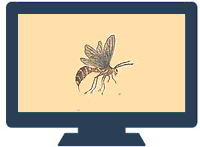Entomology, Department of

Department of Entomology: Distance Master of Science Projects
Date of this Version
2022
Document Type
Project
Citation
Master of Science Degree Project, Department of Entomology, University of Nebraska-Lincoln, 2022.
Abstract
A Guide to Agricultural Insect Pests on the East Coast is a useful resource comprised of fact sheets of ten invasive pests that have been introduced to the United States. It also includes a fact sheet of three important pollinator species that are of economic and environmental importance. Most of the pests I selected are currently an issue in states on the East coast and in some instances, further west as well. Currently, the khapra beetle is not a problem pest in the United States but does have a possibility of becoming an issue, again. The invasive pests I chose are the Asian long-horned beetle, the Emerald ash borer, the European corn borer, the introduced pine sawfly, the green peach aphid, the Japanese beetle, the khapra beetle, the pine shoot beetle, the spongy moth, and the spotted lanternfly. The three beneficial pollinators I chose are the honeybee, bumblebee, and the monarch butterfly.
The goal of this project is to educated the general public of some of the different invasive pests that may be encountered on the East coast and methods of control that can be utilized rather than constant pesticides use. Each insect pest guide has the taxonomic classification, information about the life cycle, range and habitat, general characteristics, reasons for being a pest, evidence of infestation, methods of control, and various pictures. The pollinator fact sheet includes general information, threats, and reasons for protection.
While not all pesticides are detrimental to pollinators, entomologists do suspect there are lethal and sublethal effects of pesticide use on pollinators (3). For example, dependent on time of application during the day, chemicals such as pyrethroid, may not harm honeybees, but could negatively affect bumblebees (3). Chemical control is typically the first line of defense that people utilize for controlling unwanted insect population.
The outcome of this project was successful in terms of the information that needed to be conveyed through each of the guides. I utilized many different sources for information including the USDA and university extension office websites. The significance of the project is to highlight some of the invasive pests and how to control them without the use of so many different chemicals that have the potential to negatively affect pollinators.
All references are listed on the last page of the portfolio. Numbers in parenthesis correspond to the numbered source on the reference page.


Comments
Copyright © 2022 Devan Mazza-McDonald